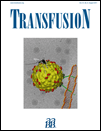The appropriateness of red blood cell use and the extent of overtransfusion: right decision? Right amount?
This study was supported by research funding from the Research and Development Office, Belfast via a Health Services and Social Care Research studentship to PB, Grant EAT/2722/04.
Abstract
BACKGROUND: Shrinkage of the donor pool coupled with an increasing demand for blood presents a major challenge to maintaining an adequate blood supply. Consequently it has become even more important to reduce inappropriate blood use, including decisions about when and how much blood to prescribe. This study aimed to ascertain the levels of inappropriate practice and factors associated with it.
STUDY DESIGN AND METHODS: The medical records of a randomly selected sample of hospital patients in Northern Ireland who received a red blood cell transfusion during 2005 (n = 1474) were reviewed, and inappropriate transfusion and overtransfusion criteria were applied. Logistic regression models were used to identify factors associated with inappropriate practice and overtransfusion.
RESULTS: In this study 23% of transfusions were considered inappropriate, occurring most commonly where the lowest hemoglobin (Hb) threshold for transfusion applied. Younger patients, those undergoing surgery, and those with lower comorbidity and higher Hb values were most likely to have an inappropriate transfusion. Among patients appropriately transfused, 19% were overtransfused. Females and those of lower weight (<65 kg) were most likely to be overtransfused.
CONCLUSION: While the choice of criteria used to judge decisions will influence the absolute level of inappropriate or overtransfusion reported, our findings suggest that a significant minority of clinicians are either unaware of or are reluctant to accept lower transfusion thresholds. To improve further improve transfusion practice we suggest that barriers to the implementation of recommended transfusion thresholds should be examined and guidance on an appropriate posttransfusion Hb level developed.




